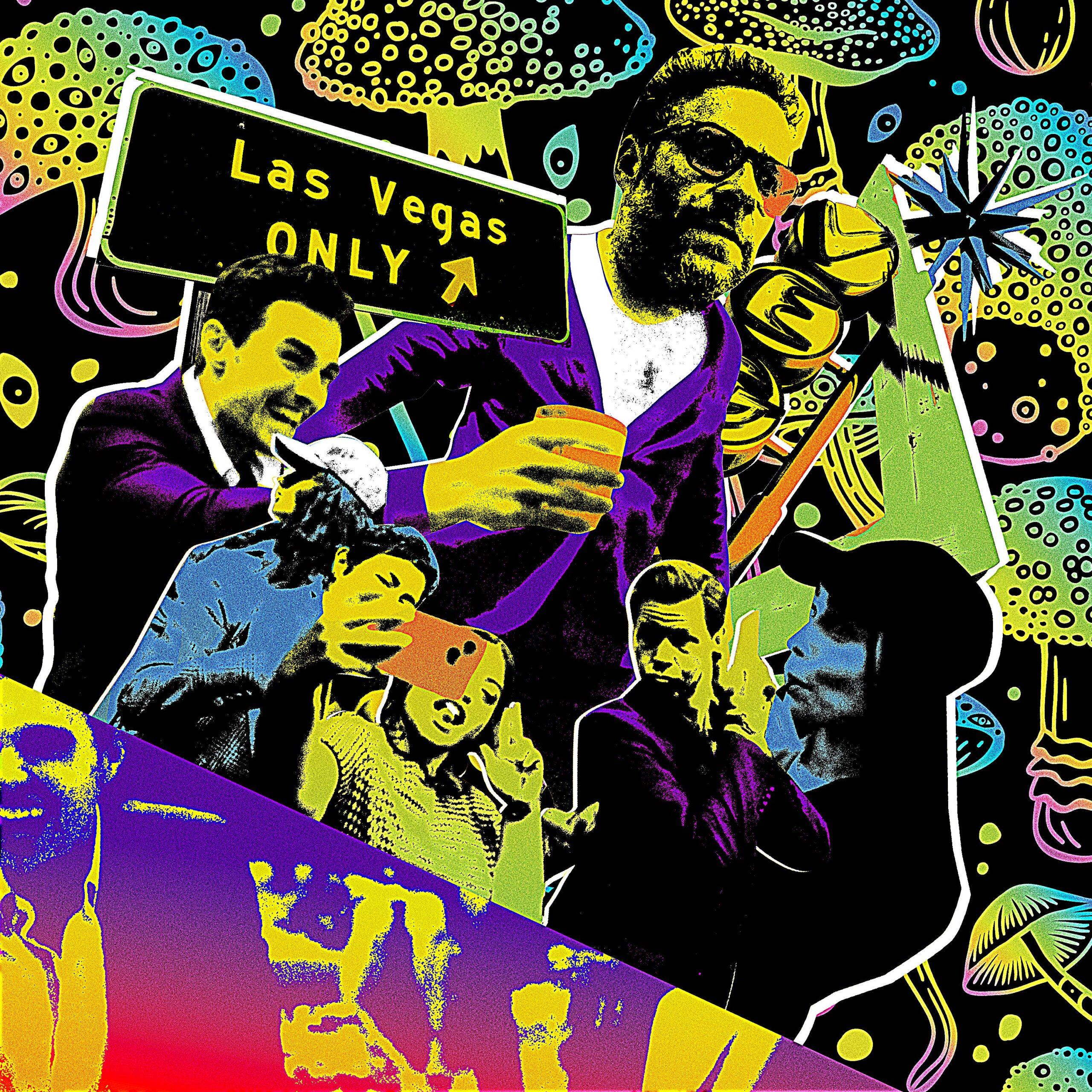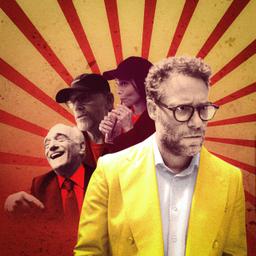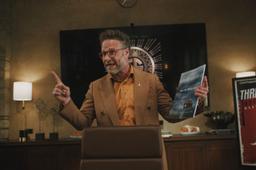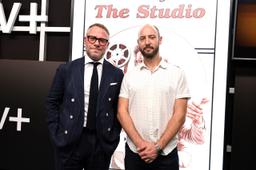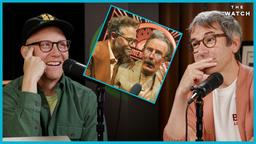Tripping Balls at CinemaCon: An Oral History of the ‘Studio’ Season Finale
What better way to end a frenetic riff on Hollywood than with some mushroom-fueled chaos in Vegas? Here’s how Seth Rogen and Co. pulled it off.When Matt Remick (Seth Rogen) gets promoted to the head of Continental Studios in the first episode of The Studio, he believes he’s been set up to fail. The studio’s CEO, Griffin Mill (Bryan Cranston), tells him that Continental has purchased the rights to Kool-Aid and that he wants his new lead man to lean into the four-quadrant, potential billion-dollar opportunity. Despite his deep nostalgia for old Hollywood and his determined commitment to make “real films,” Remick buries his pride and says, “Oh yeahhhhh.”
Over the course of Rogen and Evan Goldberg’s Hollywood send-up (which Apple TV+ recently renewed for a second season), Remick struggles to balance his artistic instincts with the job’s commercial demands: he shuts down a Martin Scorsese project; nearly ruins his relationship with Ron Howard; and gets booed onstage for hiring an AI animation company. But to close out The Studio’s first season, the writing team knew they needed to give Remick his biggest challenge yet. “We always love adding stakes to every episode,” showrunner Peter Huyck says. “But from a season arc standpoint, if in Episode 1 [Matt] gets the job, then Episode 10 has to be: ‘Does he get to keep the job?’”
The only place to find out? Las Vegas—or, more specifically, CinemaCon, an annual gathering of theatrical exhibitors, distributors, and industry professionals. On the eve of debuting Continental’s upcoming slate of movies, Remick learns that Amazon is gunning to buy the studio, making the next day’s presentation crucial to its survival. As they tend to do on this show, things get out of hand. A hotel party turns into a magic mushroom disaster, sending Remick and his entire executive team on a goose chase through the Venetian Hotel and casino floor that jeopardizes everything. “We were trying to tap into our favorite Vegas movies: Go, and Fear and Loathing, and Swingers—these raucous, drug-fueled, subversive adventures,” Rogen says. “It was incredibly physical.”
Indeed, the rambunctious, overserved, two-episode finale ratchets up the series’ stakes, doubles down on its pratfall comedy, and lets its actors—namely its guest stars Cranston, Zoë Kravitz, and Dave Franco—rip like never before. Naturally, Kool-Aid: The Movie is at the center of things, satisfying Remick’s love for a bookend. As Rogen says, the goal was always to make each episode feel cinematic, and what better way to accomplish that than by “taking all the things that have happened throughout the season and bringing them back in these last two episodes”?
But stuffing a season’s worth of characters, hijinks, and storylines into America’s playground—not to mention shooting it all in long, unbroken takes—was never a sure thing. With limited rehearsal time, thousands of tourists, and the burning Vegas sun threatening their shoot, here’s how The Studio team pulled off its feverish Season 1 conclusion.
Part 1: “It Just Doesn’t Seem Real”
When conceiving the final two episodes, the creators knew they wanted to include another industry-specific scenario that would push the show outside of the studio lot, drum up real drama from Continental’s eclectic roster of movies, and give Matt Remick the biggest stress test of his career.
Alex Gregory (creator, writer): We’d been thinking about CinemaCon for a long time.
Peter Huyck (creator, writer): A full year before we even started writing the show, we were doing research. We would meet with heads of studios, marketing heads, and assistants. We wanted everyone at every level to kind of have a voice in the show and gather information. So we were like, “We've got to go to CinemaCon.” It’s one of the biggest parts of the year for anyone who is running a movie studio.
Evan Goldberg (creator, director, writer): Seth and I have been to it many, many times, and no one else had ever been. So we eventually all went on a field trip to CinemaCon, and it exceeded expectations.
Gregory: What’s cool about CinemaCon is it's something that no one outside of the business has ever heard of. So it was a way to share some inside baseball, but in a way that’s very easy to understand. Because you're not going for a prize. You're going for buzz.
Seth Rogen (creator, director, writer, Matt Remick): It just doesn't seem real.
Frida Perez (writer): It's both very important but also feels like a performance. The studio heads come and give this dog and pony show for the exhibitors, they give awards out that they've decided on ahead of time, and they parade all the celebrities out. It feels very Hollywood.
Huyck: We were backstage in the bowels of Caesars Palace. All of the heads of the movie studios are there. I think Scorsese was talking to Rihanna in the back. We're like, “That is a pairing I would never have expected to see,” but at CinemaCon it happens because she's there to launch the Smurfs movie.
Perez: There's just really funny things that happen. They're advertising for popcorn and for chairs. And you forget, “Yeah, this is part of the cinematic ecosystem.”
Goldberg: I remember that there was a new type of sauce-injected hot dog.
Rogen: What's also funny about CinemaCon is that me and a new hot dog are the products that are lined up for the exhibitors to consume and to spend resources on. It's like, “Oh, we might get new chairs in the theater. We might get these new sauce hot dogs, and Seth Rogen has a movie!”
Perez: The location's also a part of it. Like, it's in Vegas, of all places. There's a party vibe to it. But then it's also professional, a fun mix of high and low all in one—and celebrity hot dogs.
Chase Sui Wonders (Quinn Hackett): The last two episodes were not given to us until well into filming. But there were whispers on set of Vegas and planning a big blowout for the two-part season finale. And so this was like a runner throughout the season, like, “Oh my God, we might be going to Vegas.”
Ike Barinholtz (Sal Saperstein): I kept asking. I was like, “What are you guys thinking?” And they just kind of kept dancing around it.
Gregory: We had so much to do in Vegas and we were shooting in Vegas anyway that it made sense to just do a two-parter and make it like a big homage to every raucous Vegas comedy where shit goes south.
Wonders: When the episode [scripts] finally hit, my jaw was just continually dropping. To be able to take us out with such a bang—it's no small feat. They were able to up the stakes that much more. And the stakes were already pretty high.
Rogen: [Amazon buying Continental] was the perfect existential crisis for our characters, who were committed to this sort of old-guard version of Hollywood. And Amazon literally bought MGM. Evan and I—our office used to be Louis B. Mayer's office. MGM was stamped in the doorknobs. It's a classic Hollywood institution and it was bought by the people I buy soap and toilet paper from.
Huyck: Our theory was: Amazon's still hungry. They could use more product.
Rogen: Amazon had just done it—and the phrase, "They're going to MGM us," was just making us laugh.
Gregory: With the information that they could be sold, they're not selling one movie. They're selling Continental Studios. That's why it feels like it's the Super Bowl for them.
Barinholtz: For eight episodes you've been watching people really stressed out about their jobs and at work. I was really excited that they were going to have a little bit of fun. But my first thought was: This is going to be so hard to pull off. It's so big. There's just so many variables and components to those episodes. But they really had a plan.
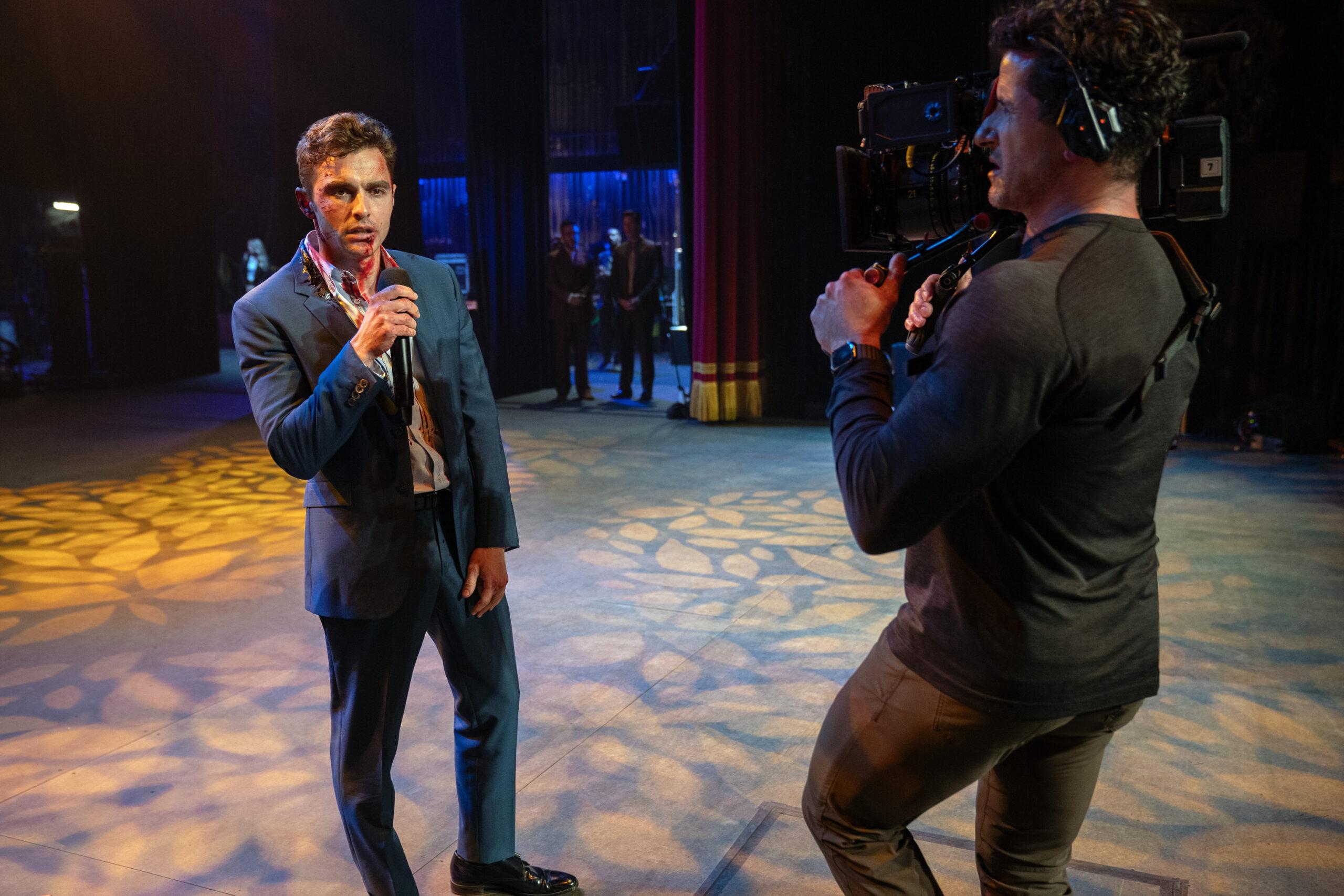
Part 2: “I Could Really Do Whatever I Want”
On the night before the presentation, Remick foists what he believes are microdoses of chocolate mushrooms onto Griffin Mill, Zoë Kravitz, Dave Franco, and the rest of his hotel room partiers. The measuring mistake, of course, turns into chaos.
Huyck: Every episode has to have very clearly defined stakes. Matt Remick has to present his slate and his job is hanging in the balance. The entire company could be sold. And in order to try to be cool, he lays out a buffet of drugs at his party and everyone accidentally overdoses.
Barinholtz: I've never heard the phrase “old-school Hollywood buffet” in relation to drugs. It made me laugh very hard every time Seth said it on set. He probably said it 500 times. But I don’t think that is a real term.
Gregory: I think it came out of a riff and it just stuck. We just got a kick out of saying it.
Huyck: We've had those stories of someone who's coming in to clean someone's house and just takes a bite of the chocolate in the fridge, doesn't realize it's actually magic mushroom chocolate, and just spends 12 hours freaking out in their home, also cleaning the house.
Gregory: I would say I have a lot less experience with mushrooms than some other members of the writing staff. So it was more just like sitting and talking to people who have done it. Just trying to capture what would be most difficult for people to deal with.
Rogen: One of our friends at a bachelor party ate exponentially more mushrooms than [he should have].
Goldberg: We told him to have three—and we meant three chocolate bar squares, but he came up to us later like, “I don't think I can finish all three of these chocolate bars.” And we were just like, “Oh, fuck.”
Rogen: Each square was like a gram of shrooms, and each bar was like 16 squares or something, and he ate three entire bars instead of three squares. So, 48 grams of shrooms or some shit like that. He really gritted his teeth and rode it out.
Gregory: They had to physically restrain him. And so we were thinking, “that's really funny if you had to do that with an actor.”
Goldberg: The funny thing about Zoë—we were filming the Globes [episode], and halfway through we were like, “We should ask her to be in the finale. She's just doing so well, and we're working so well together. “
Gregory: Originally we were thinking it would be an action movie star, so that Matt and Sal would have to wrestle a strong man to the ground. We were just kind of riffing on the idea and Zoë just said, “It should be me.”
Huyck: It made it so much funnier that instead of it being John Cena freaking out on drugs, it's Zoë Kravitz.
Gregory: All of a sudden, it opened a whole new creative window.
Barinholtz: Zoë had such a difficult part and killed it. It's hard to play really fucked up while you're playing yourself. And I think a lot of people would either go way overboard or underplay it, and if either of those happen, it's just not going to work. She just nailed it.
Wonders: She's a human being who is so sweet and beautiful and unassuming, and she just really unleashes something within that episode.
Rogen: Everyone's freaking out and panicked and she is just in this other world, like nothing is connecting. You don't even quite know how much she's absorbing or not absorbing. She started doing this funny thing where she just started repeating everything that everyone else was saying, which was so funny. That wasn't in the script, but that was also a very specific opinion about what she would be like on drugs.
Goldberg: And that was also another callback to our friend. He reached this place where, “You're not on the same plane as us anymore, dude.”
Huyck: There was a bit where there was broken glass all over and she's dancing and doing handstands and flips in between shards of broken glass. And you see our guys go, “Stop, no!”
Goldberg: We just didn't need it in the end, but it was one of my favorite scenes of the whole show. She's heartbroken it was taken out.
Dave Franco (Dave Franco): I initially show up in Episode 3 to be in this fake Ron Howard movie. And I had such a great time filming that that I literally begged Seth and Evan to bring me back.
Goldberg: From the moment he was in “The Note,” Dave Franco was just like, "Put me in the show more." We were like, “There's nowhere to put you.” And then eventually we realized we very much had a place to put him.
Franco: They said, “We have a fun way to bring you back. Everyone in the episode is extremely stressed out and you come in and you are eternally optimistic and happy about everything to a very annoying degree.”
Rogen: He was probably doing the most dramatic work on the entire show. It seemed like a waste to not have him step into the world of the show itself.
Perez: It was a natural way to bring people back that you've seen throughout the season.
Rogen: It’s true. There's sort of a classic television-finale feel to that that we liked. It's like the ragtag crew you've seen, thrown together in one big circumstance.
Barinholtz: He was killing us on set. He was so funny. First of all, he's playing this Hollywood douchebag version of himself—the opposite of Dave Franco, who's a very lovely, soft-spoken, sweet man. You're working and you're grinding out in late hours and then all of a sudden Dave Franco shows up and he has so much energy and it's a totally new vibe. And it just makes you kick it up.
Franco: I figured because it's such a weird cocktail of drugs that I could really do whatever I want. I don't think anyone could poke any holes in it. Let's just be as fucked up and loud and crazy as possible. And it was very liberating. But at the same time, it was exhausting. I remember we were doing a very long scene and after take two, Evan Goldberg came up to me and said, “You gotta conserve your energy, man. We're gonna do 16 to 18 takes of this.”
Wonders: Dave Franco's neck veins bulging at the top of his lungs because he's taken too many shrooms and he's trying to keep the party going. That will never not be funny to me.
Franco: As an actor, it's really fun to be a part of this process because even if you only have one line in the scene, you're still engaged at every single moment because the camera could catch you. And when you're doing 16 to 18 takes, you have time to take risks and have these fun discoveries and really figure out what you want to do in the scene.
Rogen: Dave hadn't been in the “oner” scenes, but he'd seen us do it, so he was very familiar with it.
Goldberg: We did one half-a-day walkthrough in the hotel a couple weeks before, and that was it.
Rogen: We had very little access to the hotel prior to filming. And even on that day, we didn't really get access to the actual room we were going to be shooting in. Thank god we shot the episodes last, because we were all much better at executing the process at that point.
Wonders: It's definitely a choreographed dance. However, I think as we found our footing filming the show, there was lots of room for us to toss out ad-libs. My character would be tasting the nacho cheese. That was worked out in the moment. The taste of nacho cheese, take after take, is permanently cemented in my brain.
Rogen: People got very good at filling in all the spaces. There’s this moment when we're turning the corner that I can try doing a thing. I don't even know if she's doing it consciously, but [Kathryn Hahn] really brings an unpredictable energy to all the scenes. As soon as rhythms start to feel too rehearsed, she will do something that knocks the rhythm off a little bit. But it makes the whole scene better.
Goldberg: Another thing that helped, too, is no one was going back to their lives in the mess of it. We would just finish, go to our hotel rooms, come back. We were within feet of the set all the time.
Perez: It did feel like we were all a little delirious.
Rogen: It felt like I was on drugs.
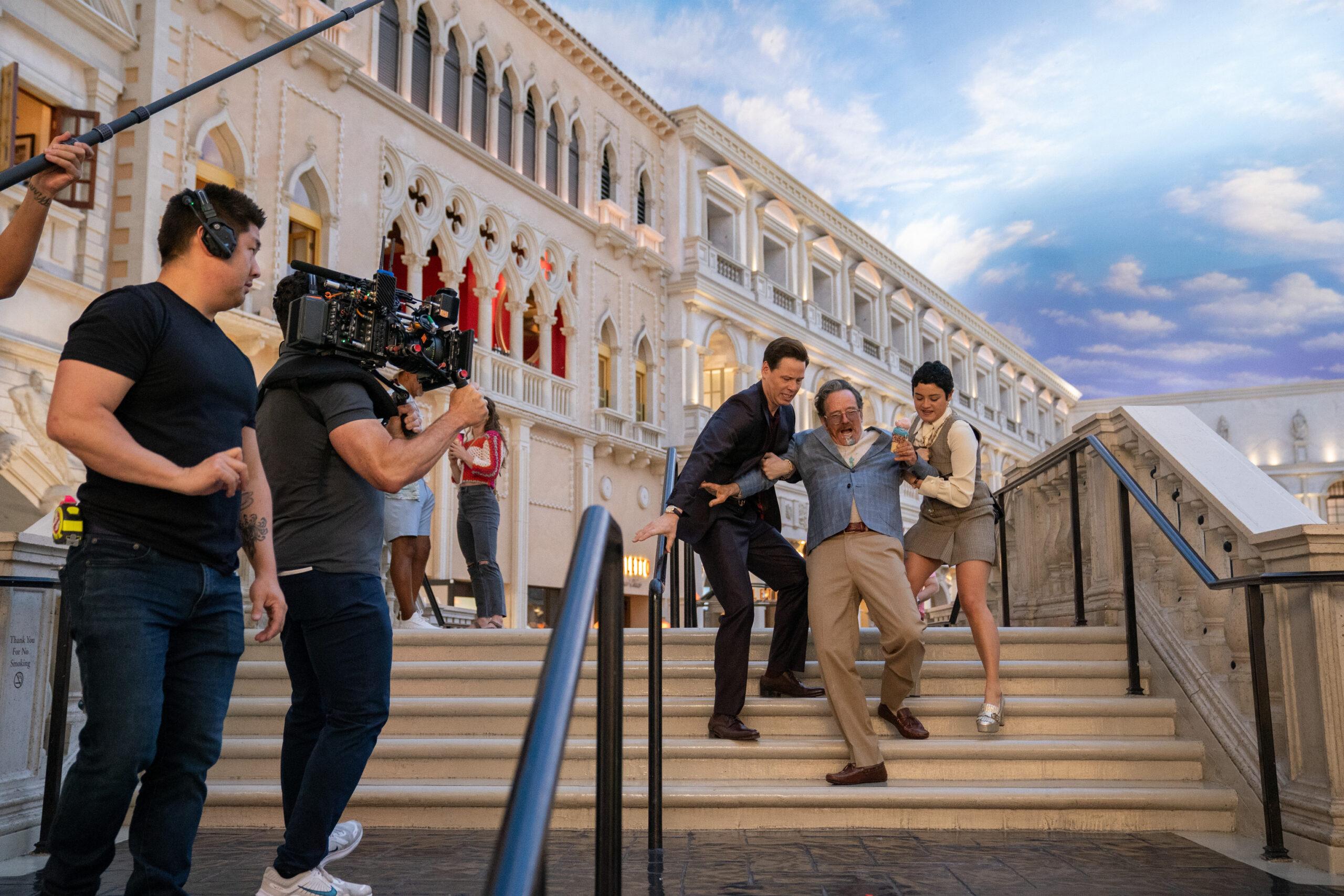
Part 3: “It's a Tour de Force Bryan Cranston Episode”
Despite the script detailing an intoxicated Griffin Mill stumbling and floating his way around the Venetian, nobody was prepared for how Bryan Cranston would embrace the drugged-out journey. The unpredictable and hilariously committed performance quickly became the biggest highlight of the season.
Rogen: One of the first ideas we had was we lose Griffin Mill and he winds up on one of these gondolas at the Venetian Hotel and floats away.
Barinholtz: I love Las Vegas. I think it's a beautiful American city. I've walked past that Venetian canal a million times and always thought, “What if someone fell in. What would happen?”
Huyck: We had to go to the Venetian for permission to film. We gave a big pitch. We're like, “OK, you're going to have people eating lobster with their hands. They’re going to be falling down. They're going to be doing piles of drugs. They're going to climb the fountain.” And they said, “As long as no one is buying the drugs in the Venetian, you can film anywhere you want.”
Goldberg: We knew that time restrictions would be real. Not only are the characters running, but it turned into us all running to get the shots. It was like, “We can shoot over the canal, but we have 90 minutes and then they're kicking us the fuck out.” We'd been living in the Venetian for 11 days straight. I have a suspicion that maybe everyone had COVID.
Rogen: Everyone in the city of Las Vegas has COVID.
Huyck: The best and the worst part of the finale is the reality of shooting in a live casino. There's 10,000 people all wandering around. Behind you are tourists from Omaha who are going to be very drunk and gambling. And in that, we're going to put Bryan Cranston eating a lobster with his bare hands and wearing a ridiculous hat with a dildo on it.
Wonders: My mom came to Vegas, and Seth and Evan were like, ”Let's put her in.” This is one of her first times ever visiting me on set. And they popped her in—she's at the casino table with Bryan Cranston, with a penis crown on his head and a lobster all over his face.
Barinholtz: We would go through hair and makeup and have like 15-20 minutes until you would have to be on set. I would just stop at a blackjack table for 10 minutes. One day I'm sitting there playing and Cranston walks past. He's like, “Are you up? What's going on?” The dealer kind of froze and goes, “Is that Bryan Cranston?” Yeah. He goes, “I think Your Honor is one of the greatest shows I've ever seen in my life.” I go, “And Breaking Bad...?” He goes, “Never seen it.”
Goldberg: We generally had this idea that Bryan was fucked up out of his mind—beyond anyone being fucked up. And Bryan really delivered on that heavily.
Perez: It's a tour de force Bryan Cranston episode.
Franco: Watching one of the greats stumble around on mushrooms is a beautiful thing to see.
Rogen: It was much funnier than I was expecting it to be. I honestly was picturing more of a stoic Weekend at Bernie's, something a little more neutral. And he just started making it so much weirder and sillier.
Huyck: You're in Las Vegas. You're on the Strip. You have Bryan Cranston in a crazy outfit on a fountain. And then he's going to fall down. And there's just tens of thousands of tourists walking by. We have to roll cameras fast. And it's a matter of time before people are in the shot, shouting stuff. “Yo, Walter White's in the fountain!” We knew that was going to happen. And so every sequence we were shooting in Vegas, we were up against it.
Barinholtz: When we came downstairs to see him outside sucking a statue's dick, I was out-of-my-body crying laughing. I was like, “What are we doing? What is happening here?”
Rogen: That was one of the few scenes on the show where I was like, “We do not have enough time to get this.” And then everyone just came together and did it.
Huyck: The funniest prank Bryan pulled on everyone—he’s like, “We're gonna run a dress rehearsal where they're trying to change me.” None of the cast knew what he was wearing. And then he goes into this bathroom with Ike Barinholtz and he comes out of the room with one of those cutoff turtlenecks. He's got a man girdle. He's got a leopard-print thong. He's got these sock garters up high. And he stumbles out of the room covered in drugs.
Barinholtz: I had to go in the bathroom with Cranston when he did the change. And it's just crazy. You're looking at this guy who's played LBJ and he's literally like, “Is my thong on straight?”
Wonders: He didn't tell anyone. It was by design that he had a waist trainer concealed under his suit. That was such a shock to everyone. He takes himself so unseriously that it is just a total gift to work with him.
Huyck: And it was such a good thing it was just a rehearsal, because everyone just loses it. The visual of Bryan Cranston, one of the respected dramatic actors of our generation, stepping out in a thong and sock garters and a girdle and a fake turtleneck.
Barinholtz: Seth told me that they were going to try to Weekend at Bernie's Cranston. The whole time I was like, “How is this going to work?
Rogen: I remember we tied our shoes together for the first time and started doing it. And it was like, “Wow, it works. You can Weekend at Bernie's somebody.”
Barinholtz: That was one of the last scenes we shot. It's probably the craziest thing I've ever done shooting—holding Bryan's body like we're in a coat together.
Rogen: It turned out a lot more physical—and had much more dynamic and kinetic energy to it—than even I was expecting it to be. Everyone was just going full steam ahead. It felt like we were just running the entire time.
Barinholtz: I just hope when Bryan accepts his Mark Twain award in a few years and they're showing a beautiful montage of his work, and it's Malcolm in the Middle and it's LBJ and Walter White—and then it’s just him on the veranda in his underpants with nacho cheese all over his face. That's what I hope he's remembered for.
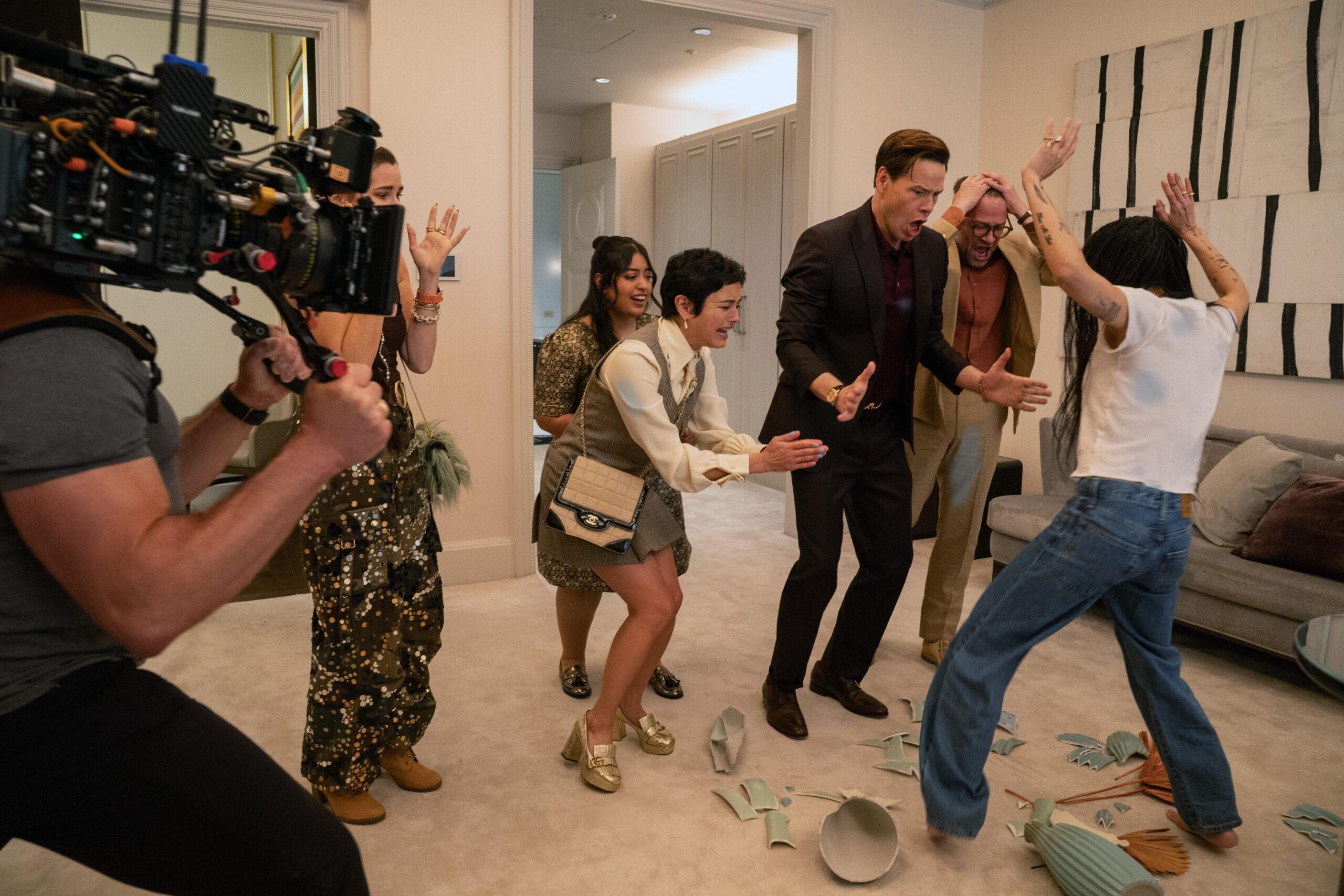
Part 4: “This Is a Man Who Loves Movies”
Throughout the season, very little has gone right for Matt Remick. But with everything on the line, a couple of actors high on mushrooms, and a Kool-Aid Man mascot waiting to descend onto the stage, the embattled studio head somehow averts disaster with a euphoric—though slightly inconclusive—call-and-response.
Gregory: If Apple goes to CinemaCon, it's like, “Hey, this is fun. We're going to show the movie we're going to release.” But ultimately, it's not life or death. It's a big deal for Paramount, Universal, 20th, Disney. For Continental, it's everything.
Rogen: And it is largely up to the performance of the studio head and what they have decided to show and not show.
Goldberg: Matt is the core of the show, and CinemaCon is the natural place where you will see a studio head come out onstage and be the center individual, which does not happen almost ever.
Rogen: It’s probably one of the more pressurized situations that they face throughout the year.
Huyck: We sat in the audience with thousands of people in this huge theater at Caesars. And you would see: one studio head launched six massive movies with the movie stars. And then another studio would be like, “OK, we're just going to present one film and we don't have any of the stars. Here's some free pizza.”
Goldberg: We were there for a Ninja Turtles movie, and the studio head came out of a sewer hole and started handing pizza slices out to people while breakdancers were doing Ninja Turtle dancing. It was just like, “This is real. This is happening right now.” And the best part? It worked.
Perez: There's a lot of showmanship from the studio head. Like, the Paramount CEO was really giving it his all out of that sewer.
Rogen: It was a very literal metaphor: a studio head emerging from a sewer. I don't know if they thought this out as much as they should have.
Huyck: We're like, “Oh, I could see them doing a thing where they have a Kool-Aid Man on wires and they're going to lower him for the audience to be excited. And then this year at CinemaCon, they brought out the new DC Superman on wires.
Gregory: It was strangely inspired by a presentation that Microsoft CEO Steve Ballmer gave, where he just started chanting, “Yeah! Yeah! Yeah!” This is a presentation from a tech CEO to rally a crowd. It was completely devoid of substance. There was nothing to it. There was no content.
Huyck: And he's frothing and he's sweating. And it looks crazy, but the crowd is going nuts. We're like, “What if the entirety of Bryan Cranston's closing speech is, ‘Movies, movies, movies’?” All the theater owners might just love it and think, ”Oh, this isn't a man who's on a pile of drugs that's been dropped from 30 feet. This is a man who loves movies.”
Gregory: We just wanted a meaningless rallying cry that somehow got everyone in the room excited. Also, realistically, what could Griffin Mill, having ingested more drugs than the entire Grateful Dead lineup at once, actually say?
Rogen: It was just a distillation of everything they're saying up there.
Huyck: Bryan started improvising how he could play on these wires and swing out over the audience. And we were like, “OK, pull back and make sure we take in this unbelievable stuff Bryan Cranston is doing on the wires because this stuff is so, so funny.”
Barinholtz: My character is in pretty advanced cocaine psychosis at that point. But what I loved is that they managed to succeed with the business. The Kool-Aid movie is probably going to work. You've been watching these four people lie, backstab, and say horrible things to each other. But then at the end, they kind of sneak in this, “Hey, we are friends.” They do kind of love each other. And they really love movies.
Huyck: Everyone was making fun of IP and how it is just this terrible thing destroying the business. And then Barbie came out and it was cool and stylish and made a billion dollars. It was so fascinating and funny, and an emotional journey that Matt could go on as the head of the studio. He takes on this thing that he doesn't want and it becomes the thing that saves his life.
Gregory: The truth is, that moment is triumphant, but it's also ambiguous. We're dealing with perception. We think they won CinemaCon. The presentation ended with an ovation, but you don't know if they've saved the studio from being sold to Amazon.
Rogen: This experience was thrilling and terrifying and made me often question our choices because they were so different from what we had done before. But that adrenaline and energy was incredibly propulsive. I was never bored on set.
Huyck: Everyone is doing their part and they all click into this beautiful puzzle. That is the best thing about the finale. Everyone comes to play and everyone gets to kill.
Wonders: A lot of people have talked about The Studio as this takedown, this indictment of Hollywood. But the last two episodes really teach you how much love and respect and honor we all have for this strange little world of showbiz.
Goldberg: This is the most thrilling thing I've ever worked on. It’s insanely addictive. And it's going to be hard to go back to doing anything any other way.
Interviews have been edited and condensed.
